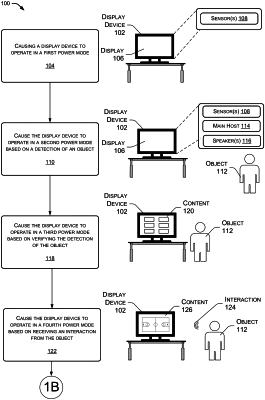| CPC H04N 21/44218 (2013.01) [H04N 21/4436 (2013.01)] | 19 Claims |

|
1. A television comprising:
a radar sensor configured to:
while the television is operating in a standby-passive mode, generate sensor data;
analyze the sensor data to detect a possible object; and
determine that the possible object is located within a threshold distance to the television;
a display;
one or more processors; and
one or more computer-readable media storing instructions that, when executed by the one or more processors, cause the one or more processors to perform operations comprising:
causing the television to operate in the standby-passive mode by at least deactivating the display;
causing the radar sensor to operate in a first presence-detection mode, wherein the radar sensor is configured to detect the possible object while operating in the first presence-detection mode by:
analyzing the first sensor data using a first presence-detection technique to determine a magnitude of a frequency associated with a signal;
determining, based on the first sensor data, a peak magnitude associated with the magnitude;
determining, based on the first sensor data, that the peak magnitude satisfies a threshold magnitude; and
detecting a possible object based at least in part on the peak magnitude satisfying the threshold magnitude;
receiving, from the radar sensor, first output data indicating that the radar sensor detected the possible object;
based at least in part on receiving the first output data, causing the television to operate in a standby-active mode by at least activating a processing component;
while the television is operating in the standby-active mode:
receiving second output data from the radar sensor, the second output data indicating at least a distance to the possible object; and
analyzing, using the processing component, the second output data to verify that the possible object is an actual object;
based at least in part on verifying that the possible object is the actual object, causing the television to operate in an ambient mode by at least:
activating the display; and
causing the display to present a user interface;
while the television is operating in the ambient mode, detecting an interaction associated with the actual object; and
based at least in part on detecting the interaction, causing the television to operate in an active mode by at least:
receiving video data from one or more sources; and
causing the display to present content represented by the video data.
|